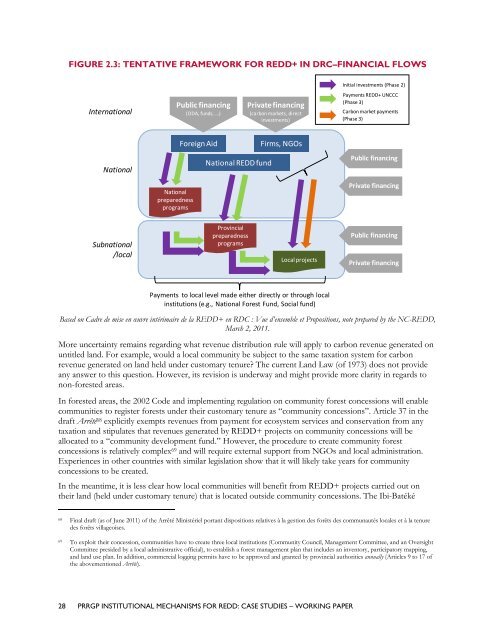Institutional Mechanisms for REDD+ - Case Studies Working Paper
Institutional Mechanisms for REDD+ - Case Studies Working Paper
Institutional Mechanisms for REDD+ - Case Studies Working Paper
You also want an ePaper? Increase the reach of your titles
YUMPU automatically turns print PDFs into web optimized ePapers that Google loves.
FIGURE 2.3: TENTATIVE FRAMEWORK FOR <strong>REDD+</strong> IN DRC–FINANCIAL FLOWS<br />
International<br />
National<br />
Subnational<br />
/local<br />
National<br />
preparedness<br />
programs<br />
Public financing<br />
(ODA, funds, …)<br />
Private financing<br />
(carbon markets, direct<br />
investments)<br />
Foreign Aid Firms, NGOs<br />
National REDD fund<br />
Provincial<br />
preparedness<br />
programs<br />
Local projects<br />
Payments to local level made either directly or through local<br />
institutions (e.g., National Forest Fund, Social fund)<br />
Based on Cadre de mise en œuvre intérimaire de la <strong>REDD+</strong> en RDC : Vue d’ensemble et Propositions, note prepared by the NC-REDD,<br />
March 2, 2011.<br />
More uncertainty remains regarding what revenue distribution rule will apply to carbon revenue generated on<br />
untitled land. For example, would a local community be subject to the same taxation system <strong>for</strong> carbon<br />
revenue generated on land held under customary tenure? The current Land Law (of 1973) does not provide<br />
any answer to this question. However, its revision is underway and might provide more clarity in regards to<br />
non-<strong>for</strong>ested areas.<br />
In <strong>for</strong>ested areas, the 2002 Code and implementing regulation on community <strong>for</strong>est concessions will enable<br />
communities to register <strong>for</strong>ests under their customary tenure as ―community concessions‖. Article 37 in the<br />
draft Arrêté 68 explicitly exempts revenues from payment <strong>for</strong> ecosystem services and conservation from any<br />
taxation and stipulates that revenues generated by <strong>REDD+</strong> projects on community concessions will be<br />
allocated to a ―community development fund.‖ However, the procedure to create community <strong>for</strong>est<br />
concessions is relatively complex 69 and will require external support from NGOs and local administration.<br />
Experiences in other countries with similar legislation show that it will likely take years <strong>for</strong> community<br />
concessions to be created.<br />
In the meantime, it is less clear how local communities will benefit from <strong>REDD+</strong> projects carried out on<br />
their land (held under customary tenure) that is located outside community concessions. The Ibi-Batéké<br />
68 Final draft (as of June 2011) of the Arrêté Ministériel portant dispositions relatives à la gestion des <strong>for</strong>êts des communautés locales et à la tenure<br />
des <strong>for</strong>êts villageoises.<br />
69 To exploit their concession, communities have to create three local institutions (Community Council, Management Committee, and an Oversight<br />
Committee presided by a local administrative official), to establish a <strong>for</strong>est management plan that includes an inventory, participatory mapping,<br />
and land use plan. In addition, commercial logging permits have to be approved and granted by provincial authorities annually (Articles 9 to 17 of<br />
the abovementioned Arrêté).<br />
28 PRRGP INSTITUTIONAL MECHANISMS FOR REDD: CASE STUDIES – WORKING PAPER<br />
Initial investments (Phase 2)<br />
Payments <strong>REDD+</strong> UNCCC<br />
(Phase 3)<br />
Carbon market payments<br />
(Phase 3)<br />
Public financing<br />
Private financing<br />
Public financing<br />
Private financing

















